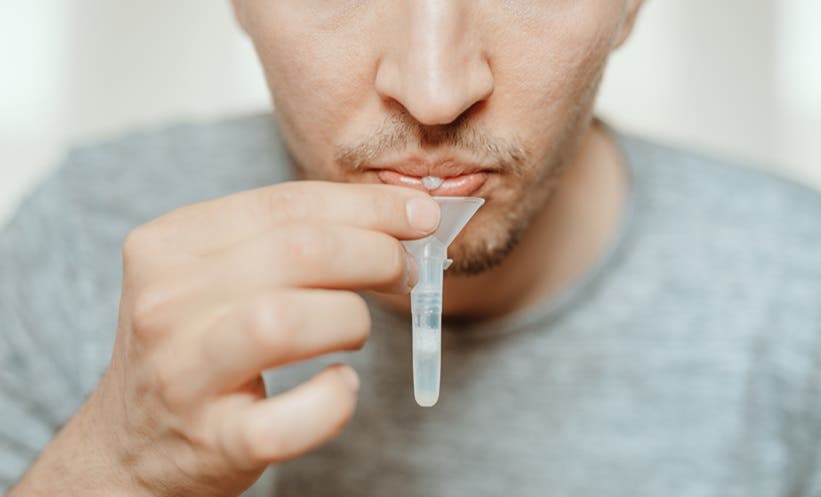Painless saliva insulin test offers early signs of diabetes and obesity risk
Study shows saliva insulin testing is a non-invasive way to predict diabetes risk years early, offering a painless alternative to blood work.

UBCO study reveals that a basic saliva test designed to measure insulin may also detect early metabolic shifts associated with obesity and related health risks. (CREDIT: CC BY-SA 4.0)
For decades, checking your metabolic health meant a needle. It involved a trip to a clinic, a blood draw, and a wait for lab results. This process measures key markers like blood sugar. But it often catches problems only after they have started. It can miss the earliest warning signs of trouble. What if there was a simpler, painless way to look into your body’s future? What if you could get a vital snapshot of your health risk with just a bit of spit?
Groundbreaking research from the University of British Columbia (UBC) Okanagan suggests this is now possible. A team of scientists has shown that measuring insulin levels in your saliva is a powerful tool. It can predict your risk of developing obesity and Type 2 diabetes. This simple spit test can spot hidden metabolic changes long before they show up in standard blood work. It offers a non-invasive window into your health, no needles required.
The work, published in the journal Applied Physiology, Nutrition, and Metabolism, could reshape how you and your doctor screen for chronic diseases. It promises a future where early detection is easier and more accessible for everyone. By catching the silent signals your body sends out, this method gives you the power to act sooner. You can make lifestyle changes to protect your health for years to come.
The Problem with High Insulin
Your body uses a hormone called insulin to manage blood sugar. It helps move sugar from your blood into your cells for energy. Sometimes, your body stops responding well to insulin. This is called insulin resistance. To overcome this, your pancreas works overtime. It pumps out more and more insulin to get the job done. This leads to a condition of elevated insulin in your blood. Doctors call this state hyperinsulinemia.
Hyperinsulinemia is a critical, early warning sign. It tells you your metabolic system is under strain. Dr. Jonathan Little, a Professor at UBC Okanagan’s School of Health and Exercise Sciences, notes that this condition can appear years before a formal diagnosis. “Prediabetes conditions – such as insulin resistance and hyperinsulinemia – may develop 10 to 20 years before a person is diagnosed,” he says. This is a huge, silent window of opportunity.
Catching high insulin early is vital. It is a known predictor of many serious health issues. These include Type 2 diabetes, high blood pressure, and heart disease. It has also been linked to stroke and even some types of cancer. If you can spot hyperinsulinemia before blood sugar levels creep up, you have a head start.
Related Stories
- Groundbreaking new study could change the way we detect, predict, and manage diabetes
- From nerves to bones: How diabetes changes the human skeleton
- Oxytocin nasal spray shows promise for treating alcoholism and obesity
“People at risk for Type 2 diabetes could be identified early,” Dr. Little explains. This allows for “lifestyle changes and other treatments to be introduced long before glucose levels rise.” This proactive approach is the key to preventing chronic disease.
The Promise of Saliva Insulin Testing
The UBC Okanagan team wanted to find a practical, painless way to measure insulin. They designed a study with 94 healthy adults. The participants represented a wide range of body sizes. First, everyone fasted for a few hours. Then, they each drank a standardized meal-replacement shake. This shake was designed to trigger an insulin response from the body. Over the next 90 minutes, the researchers collected saliva samples. They also took small finger-prick blood samples to check glucose levels.
The results were incredibly clear. The saliva told a story that the blood sugar did not. “People living with obesity had much higher insulin levels in their saliva than those who were slightly overweight or had lower body weight – even though their blood sugar levels were the same,” says Dr. Little. This is the crucial finding. The saliva test was more sensitive. It picked up on the hidden metabolic stress in people with obesity. Their bodies were working much harder to keep their blood sugar normal.
This suggests saliva can effectively distinguish between people who are healthy and those who are on the path to disease. “This suggests that saliva testing could be a simple, non-invasive way to identify people at risk of Type 2 diabetes before symptoms appear,” Dr. Little concludes. This kind of early warning system has been a long-sought goal in preventive medicine. The power of saliva insulin testing is its ability to reveal this hidden struggle.
More Than Just Weight
The study uncovered another fascinating insight. It challenges the common belief that only people with excess weight are at risk. Co-author Dr. Hossein Rafiei points out that some lean participants also showed large spikes in saliva insulin after the meal. This was a surprise. These individuals appeared healthy. Their body weight was normal. Their blood glucose was normal. Yet, their saliva revealed a hyperinsulinemic response. Their bodies were struggling to handle the meal.
This finding is important. It shows that you cannot always judge metabolic health by looking at the scale. “The finding that some people who are lean have high insulin is intriguing,” says Dr. Rafiei. “This indicates that saliva insulin may be more useful than measuring someone’s weight or waist size.” It suggests some lean people may carry a hidden risk for Type 2 diabetes. This is a risk that traditional screening methods would completely miss.
The research also looked at what physical measures best predict high saliva insulin. They compared body mass index (BMI), age, sex, and waist circumference. The strongest link was found with waist size. A larger waist was a more reliable indicator of hyperinsulinemia than overall weight. This supports growing evidence that fat stored around the abdomen is particularly harmful to metabolic health. Combining a simple waist measurement with saliva insulin testing could create a powerful and practical screening tool for your doctor’s office.
A New Era for Your Health
So, what does this all mean for you? It could revolutionize how you manage your health. Imagine going for a check-up and providing a simple saliva sample. This sample could tell your doctor if your body is showing early signs of insulin resistance. You could get this information years before your blood sugar starts to rise. This knowledge is power. It gives you time to make meaningful changes. You could adjust your diet, start a new exercise routine and prevent a future diagnosis of Type 2 diabetes.
This method democratizes health screening. It is painless and requires no special equipment for collection. It would be easy to implement in community clinics, pharmacies, or even remote areas. People who are afraid of needles would no longer have a barrier to getting checked. This broader access could help reduce health disparities. More people could get the early warnings they need to protect their future.
Of course, the technology still needs more research. The team’s findings must be confirmed in larger, more diverse groups of people. Scientists will need to refine the techniques to ensure accuracy and establish clear cut-off values for risk. But this study lays a compelling foundation. Dr. Rafiei’s previous work already showed that saliva insulin closely tracks blood insulin throughout the day.
This new study builds on that, showing its power in a standardized test. The future of metabolic health may not be in your veins, but in your mouth. The continued development of saliva insulin testing holds the potential to shift medicine from treatment to true prevention.
Note: The article above provided above by The Brighter Side of News.
Like these kind of feel good stories? Get The Brighter Side of News' newsletter.



